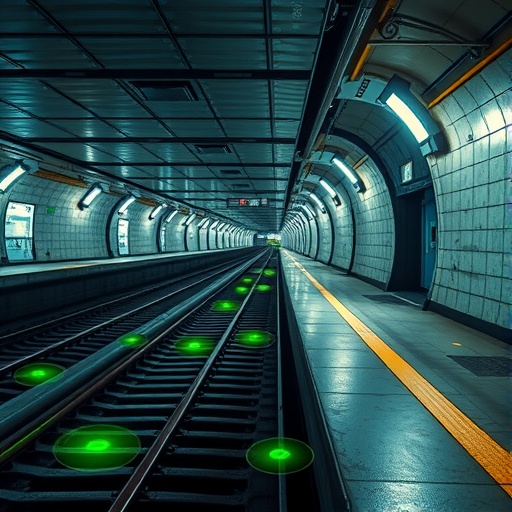In an ambitious move toward enhancing urban infrastructure, researchers are turning their attention to the exploration and exploitation of underground spaces in cities. With the rapid expansion of urban areas and the increasing pressure on available land, innovative technologies for detecting and utilizing these hidden spaces have never been more relevant. The ongoing research led by Yu, Xing, and Ge emphasizes multifaceted underground space detection techniques, particularly in the context of smart city development in Hangzhou, China.
Cities around the globe are experiencing unparalleled growth, leading to significant challenges in urban planning and resource management. As the population density escalates, the demand for efficient land use drives the necessity for developing underground spaces. This not only alleviates pressure on surface structures but also offers a sustainable solution to developing new facilities without disrupting existing urban landscapes. The research aims to create a systematic approach to underground exploration and utilization.
The study offers a comprehensive overview of various underground detection technologies, utilizing advanced methodologies such as ground-penetrating radar (GPR), electromagnetic induction, and geological mapping. Each of these technologies provides vital insights into subsurface conditions, allowing urban planners to make informed decisions regarding land use and infrastructure development. By combining these techniques, researchers can maximize the effectiveness of underground space detection, yielding a holistic understanding of geological structures.
Ground-penetrating radar (GPR), in particular, stands out as a crucial tool in the research. It employs high-frequency radio waves to image subsurface structures, making it ideal for determining soil composition, locating utilities, and identifying voids or anomalies beneath the surface. The effectiveness of GPR has been well-documented in various studies, and its integration into urban planning can transform how cities approach subsurface analysis.
Another key technology discussed in the research is electromagnetic induction. This method relies on measuring the electromagnetic response of the ground to identify buried objects and the composition of subsurface materials. Its ability to penetrate various soil types allows for versatile applications, ultimately enhancing the capacity to explore and map underground environments in urban settings. Integrating these technologies fosters an improved understanding of the subterranean landscape, paving the way for future urban developments.
Geological mapping complements these detection techniques by providing essential contextual information regarding the geological characteristics of the area. This data is instrumental in guiding urban planners and engineers in designing infrastructure that is not only functional but also resilient to geological challenges. The synthesis of geological data with advanced detection technologies leads to better risk management and informed decision-making regarding underground infrastructure projects.
Moreover, the research highlights the importance of incorporating these detection approaches within a broader framework of sustainable urban development. As cities evolve, the necessity for adaptable and efficient infrastructure grows. Underground space utilization is positioned to contribute significantly to meeting urban demands while preserving surface environments. This approach aligns perfectly with the principles of smart city development, where technological innovation plays a vital role in enhancing living conditions.
The implementation of combined underground space detection methodologies also presents numerous opportunities for innovation. For instance, fusion of data collected from various techniques can lead to enriched datasets that provide more accurate representations of underground conditions. This merging of information facilitates higher precision in planning and development, which is critical in densely populated urban areas where the margin for error is minimal.
Furthermore, the research underscores the collaborative efforts required among multiple stakeholders, from policymakers to engineers. Successful underground spatial planning necessitates a multidisciplinary approach that encompasses environmental, architectural, and engineering disciplines. Effective collaboration fosters shared responsibility and enables a dynamic approach to urban development that leverages the strengths of each sector involved.
As cities like Hangzhou continue to grow, the integration of comprehensive underground space detection technologies becomes increasingly essential. This research not only presents a methodological framework for urban planning but also encourages the exploration of innovative solutions to manage urban expansion sustainably. The significance of this study extends beyond the immediate context of Hangzhou; it sets a precedent for smart city development strategies worldwide.
In light of the findings, it is clear that the path to sustainable urbanization lies beneath the surface. By unlocking the potential of underground spaces, cities can address pressing issues such as housing shortages, infrastructure strain, and environmental concerns. These insights can catalyze a paradigm shift in how municipalities approach urban design and development, fostering resilience and adaptability in an ever-changing world.
The authors of the study, Yu, Xing, and Ge, emphasize that the successful implementation of these techniques hinges not only on technological innovation but also on the willingness of urban authorities to embrace new methods. Stakeholders must recognize the long-term benefits that effective underground space detection can offer, thus paving the way for a transformative impact on urban landscapes.
Ultimately, the continued exploration and evaluation of underground space detection techniques will inform future urban planning initiatives, fostering a thoughtful and responsive approach to the challenges cities face today. The ongoing evolution of technologies and methodologies promises an exciting future for urban infrastructure, paving the way for more livable and sustainable urban environments.
In conclusion, the multifaceted underground space detection techniques presented in this groundbreaking research represent a crucial step toward smarter urban development. The profound implications of these findings highlight the importance of interdisciplinary collaboration in addressing urban challenges. The journey into the underground realm has just begun, and it holds the key to building the smart cities of tomorrow.
Subject of Research: Underground Space Detection Techniques for Smart City Development
Article Title: Multifaceted Underground Space Detection Techniques for Smart City Development: A Combined Approach in Hangzhou, China.
Article References:
Yu, B., Xing, H., Ge, W. et al. Multifaceted Underground Space Detection Techniques for Smart City Development: A Combined Approach in Hangzhou, China. Nat Resour Res (2025). https://doi.org/10.1007/s11053-025-10566-y
Image Credits: AI Generated
DOI: https://doi.org/10.1007/s11053-025-10566-y
Keywords: Underground space detection, smart city development, sustainable urban planning, ground-penetrating radar, electromagnetic induction, geological mapping.




